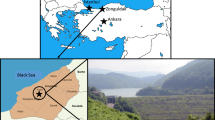Abstract
This research work was carried out using Geo-Slope software programmes, i.e., to compute the infiltration and slope stability analysis of the Grindeho dam using SEEP/W and SLOPE/W. Embankment dam failure may occur due to different reasons, such as structural instability, hydraulic conditions, seepage through the dam body and foundation. The determination of the factor of safety for the dam slope stability and quantify the amount of seepage through the dam, under different cases of operations, is vital to ascertain the dam overall safety. In this research, Finite Element modelling is used through Geo-Studio software to simulate slope stability and seepage analysis of the embankment dam. Three distinct operational cases are considered for the dam analysis: end of construction before filling the reservoir, after/full reservoir condition, and rapid reservoir condition drawdown. Four separate methods of analysis were used to verify the stability of the slope embankment: Morgenstern-Price, Bishop, Janbu, and Spencer. The requirements of the Benchmark Safety Legislation (US Army of Corps Engineers and British Dam Society) are observed. The simulation results of the upstream and downstream side of the dam section have a direct effect on the factor of safety, the outcome of the stability analysis performed showed that all sections of the dam are safe within the specified range of factors of safety for the potential all loading and operation cases. But all the slip surfaces move through the section of the dam shell, which shows that this zone is the weaker zone and requires spatial attention. The simulation results obtained from the SEEP/W program revealed that 15,291.5 m3/year and 22,818.56 m3/year amount of seepage loss is present in the Grindeho dam during the drawdown case and full reservoir case, respectively.


























Similar content being viewed by others
References
A report produced for the G20 Presidency of Germany (2017). Water for Sustainable Food and Agriculture Water for Sustainable Food and Agriculture
Bewket W (2008) Rainfall variability and agricultural vulnerability in the Amhara Region, Ethiopia. Ethiopian J Develop Res 29(1):823–836
Head, Deputy (2020) Cuma CAKMAK, Deputy Head, State Hydraulic Works (DSI), The Role of Dams in Development. Pp. 59–63
Htwe, Hla M, Tun N (2017) Seepage and slope stability analysis of myittha multipurpose dam project, Gangaw Township, Magway Region, Myanmar. In: IPTEK Journal of Proceedings Series 3(6)
Levee S (2012) Dam and Levee safety and community resilience: a vision for future practice dam and levee safety and community resilience: a vision for future practice
Liu F, Zhao J (2013) Limit analysis of slope stability by rigid inite- element method and linear programming considering rotational failure. Int J Geomech 13(6):827–839
Mishal, Usama R, Thair K (2018) stability analysis of an earth dam using GEO-SLOPE model under different soil conditions. Eng Technol J 36(5A)
Sam J (1997) Doctoral dissertation, Department of Civil and Seepage Monitoring in Embankment Dams. https://kth.diva-portal.org/smash/get/diva2:8066/FULLTEXT01
Schmertmann JH (2004) Discussion of ‘time for development of internal erosion and piping in embankment dams.’ J Geotech Geoenviron Eng 130(9):980–980
US Army Corps (2003) Engineering and design, slope stability, engineer manual. US Army Corps of Engineers 49(3):EM 1110-2-1902
Yousuf M (2018) A comparison between limit equilibrium and finite element methods for slope stability analysis. 0–17

Author information
Authors and Affiliations
Corresponding author
Additional information
Publisher's Note
Springer Nature remains neutral with regard to jurisdictional claims in published maps and institutional affiliations.
Rights and permissions
About this article
Cite this article
Hailu, M.B. Modeling assessment of seepage and slope stability of dam under static and dynamic conditions of Grindeho Dam in Ethiopia. Model. Earth Syst. Environ. 7, 2231–2239 (2021). https://doi.org/10.1007/s40808-020-01006-2
Received:
Accepted:
Published:
Issue Date:
DOI: https://doi.org/10.1007/s40808-020-01006-2





